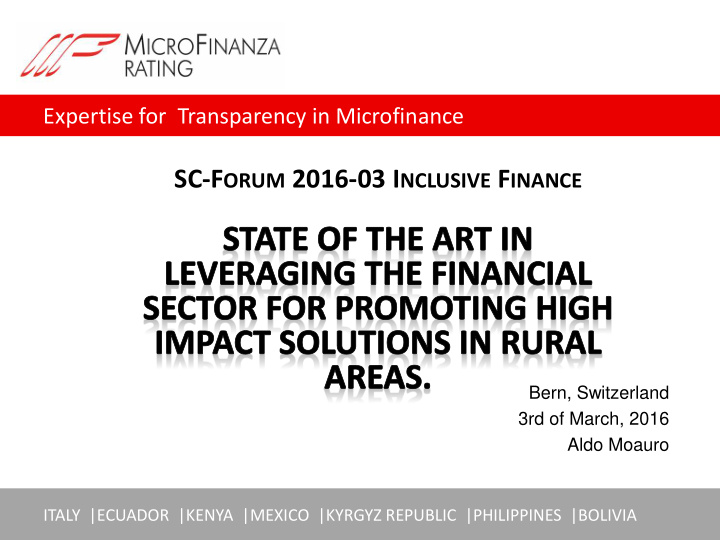



Expertise for Transparency in Microfinance SC-F ORUM 2016-03 I NCLUSIVE F INANCE Bern, Switzerland 3rd of March, 2016 Aldo Moauro ITALY |ECUADOR |KENYA |MEXICO |KYRGYZ REPUBLIC |PHILIPPINES |BOLIVIA
1990’s : Maximalist vs. Minimalist approach • Compartamos arose from the NGO “ Gente Nueva ”, which initially focused on health and education when it was founded in 1982 • The World Bank’s Consultative Group to Assist the Poor (CGAP) conventional microfinance thought began favoring a “ commercial approach ” from 1990 onwards 2
Minimalist • Emphasis on financial self-sufficiency • Financial service provision only • Provision of non-financial services considered too costly and difficult to manage, especially for small MFIs 3
The Evolution Continued technological and organizational innovations had enabled MFIs to offer evermore- tailored financial and nonfinancial services in recognition of the multi-dimensionality of poverty 4
Microfinance Plus (Maximalist) • Building links between microfinance and other development programmes, for example, in health , education and environment . • Value chains , and the strategic targeting of microfinance services along them 5
Cornerstone for a MF-plus approach Business model Dependency on grants Sustainability Linkage FS with NFS Development Reputation risk projects management 6
MFI perspective • What N-F services to deliver? Level of functionality to the F services? With which operational approach? • Higher operational costs passed on to clients through higher interest rates. Is sustainability possible? • Benefit to be measured (RCT) and demonstrated (reputation) – Financial education – Desease prevention – Loyalty to the MFI – Business capacity – Confidence and self-esteem • N-F services: to be well adapted to the needs of borrowers 7
Leveraging financial sector (MFIs) for promoting impact solutions • From «project-focus» to «institution-building» approach • Leveraging the financial sector: aggregation points of «beneficiaries» sustainability, permanent effects, «institutionalization» of the FS and N-FS • Push (and support) FIs towards the frontiers and higher impact Innovative financial services to riskier targets (youth, start-ups, agro) Support consolidation of already existing operations by FIs • Different models: MIV+TA facility Multilateral donors partnering with identified local FIs DFIs offering F+N-F facilities to selected local FIs 8
Guiding remarks/(recommendations) for funders • Selection of partner FIs – Commitment + Capacity – Buy-in of the project – Pilot-testing the operational scheme • Exit strategy – Especially for N-F Services • Incentive system – Gradual disbursements (against results) – Reporting standards – Definition of KPIs and monitoring – Third-party financial and social assessments – RCTs exercises 9
Thank you! Expertise for Transparency in Microfinance Expertise for Transparency in Microfinance MF Rating HQ Via Rigola, 7, 20159 Milan – Italy. Tel: +39-02-3656.5019 MF Rating Latin America Calle Pasaje El Jardín #152 y Avenida 6 de Diciembre, Quito – Ecuador. Tel.: +593-2-2248.114 Calle Gavino Villanueva #345 Calacoto, La Paz – Bolivia Tel: +591 22790539 MF Rating Mexico Av. Patriotismo 229 Piso 8, Ciudad de México DF, CP 03800. Tel. +52 55 2881.0394. Tel. +52 222 284.52.01 MF Rating Central Asia 231 Tynystanova Str., apt. 14. 720011, Bishkek, Kyrgyz Republic. Tel: +996-312-624441 MF Rating Africa Royal Offices, Mogotio Road, Westlands, Nairobi – Kenya Mob: +254‐737 43.9297 MF Rating South East Asia Unit 34 Cattleya Gardens, 111 C. Palanca St., Makati City, Metro Manila, Philippines. Tel: +63 2 8173767 www.microfinanzarating.com | info@microfinanzarating.com
Recommend
More recommend